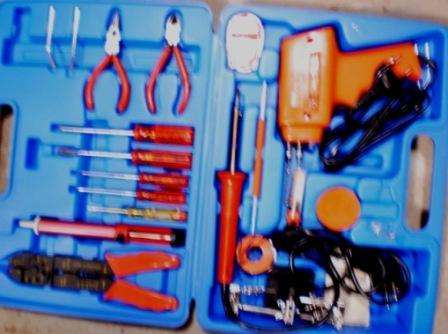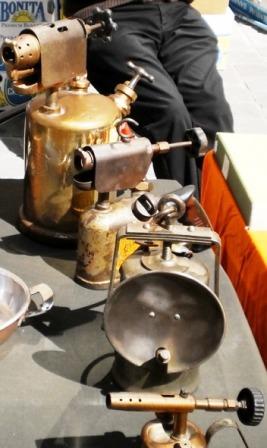Soldering is connect metal parts to each other by a metal alloy (solder) having a melting point lower than the parts to be connected (also with a different composition) which are not (such as welding) melting too.
 Soldering: at a relatively low temperature (< 450°C, 200°C), alloys based on tin, copper and silver in varying compositions are melted on work surfaces that are heated with a soldering iron or torch. Formerly an ‘iron’ was a heavy copper ax heated in the fire. Heavy, to hold the heat long enough and pointed to concentrate this heat in the point.
Soldering: at a relatively low temperature (< 450°C, 200°C), alloys based on tin, copper and silver in varying compositions are melted on work surfaces that are heated with a soldering iron or torch. Formerly an ‘iron’ was a heavy copper ax heated in the fire. Heavy, to hold the heat long enough and pointed to concentrate this heat in the point.
Then came gasoline burners. At the top of the tank around the transit pipe there was a dent. In there you poured some gasoline and let it burn. By this heat gasoline was gassed in the tank and driven out. That burned like the current gas burners, and the fire kept the system working.
Tin-lead solder contained lead up to 2006 in order to decrease the melting temperature about 40°C.
Hydrochloric acid in the required fluxes to prevent corrosion is now also prohibited.
Flux (liquid or resin) is also in the resin core of solder wire. It prevents oxidation during work.
The work pieces must first be cleaned thoroughly, and degreased, sanded, and edge beveled to make space for the weld.
The flame should be directed at the workpiece, not to the solder, solder can burn. When mating pipe (fittings) the very narrow space is filled by the capillary force: the solder between is rising up.
Soldering is mainly used for electronic components, tubes, stained glass.
A ‘capilla’ surfactant is a hair. A capillary tube is a very thin nozzle or tube which can be used in order to suck up fluid.
 Capillarity or capillary action is the phenomenon of liquid rising in a very fine tube by cohesion, adhesion, and surface tension higher than the surrounding fluid level. The finer the tube, the higher the water can reach (because the body of water (by weight) is less than).
Capillarity or capillary action is the phenomenon of liquid rising in a very fine tube by cohesion, adhesion, and surface tension higher than the surrounding fluid level. The finer the tube, the higher the water can reach (because the body of water (by weight) is less than).
The absorption of water by brick (rising moisture) is an example of this, as well as the finest blood vessels in our body. They constitute our capillary system.
A candle wick or lamp wick sucks oil by capillary force.
In the bottom capillary tubes are formed by the concatenation of small cavities which rise the groundwater.
The xylem in plants and trees can thus let the water rise to (limited) great heights.
The principle is used in the soldering where the by heating made liquid solder penetrates in the very narrow gap between couplers or cracks. Therefore, the parts, and not the solder has to be heated.
Brazing or hard soldering is done at higher temperature (450°C - 900°C), with the brazing alloys based on copper, zinc and with (20% or more) silver.
It is called brazing referring to brass.
More info can be found on http://rossa.nl/Cursus/Solderen/alles_over_solderen.htm
